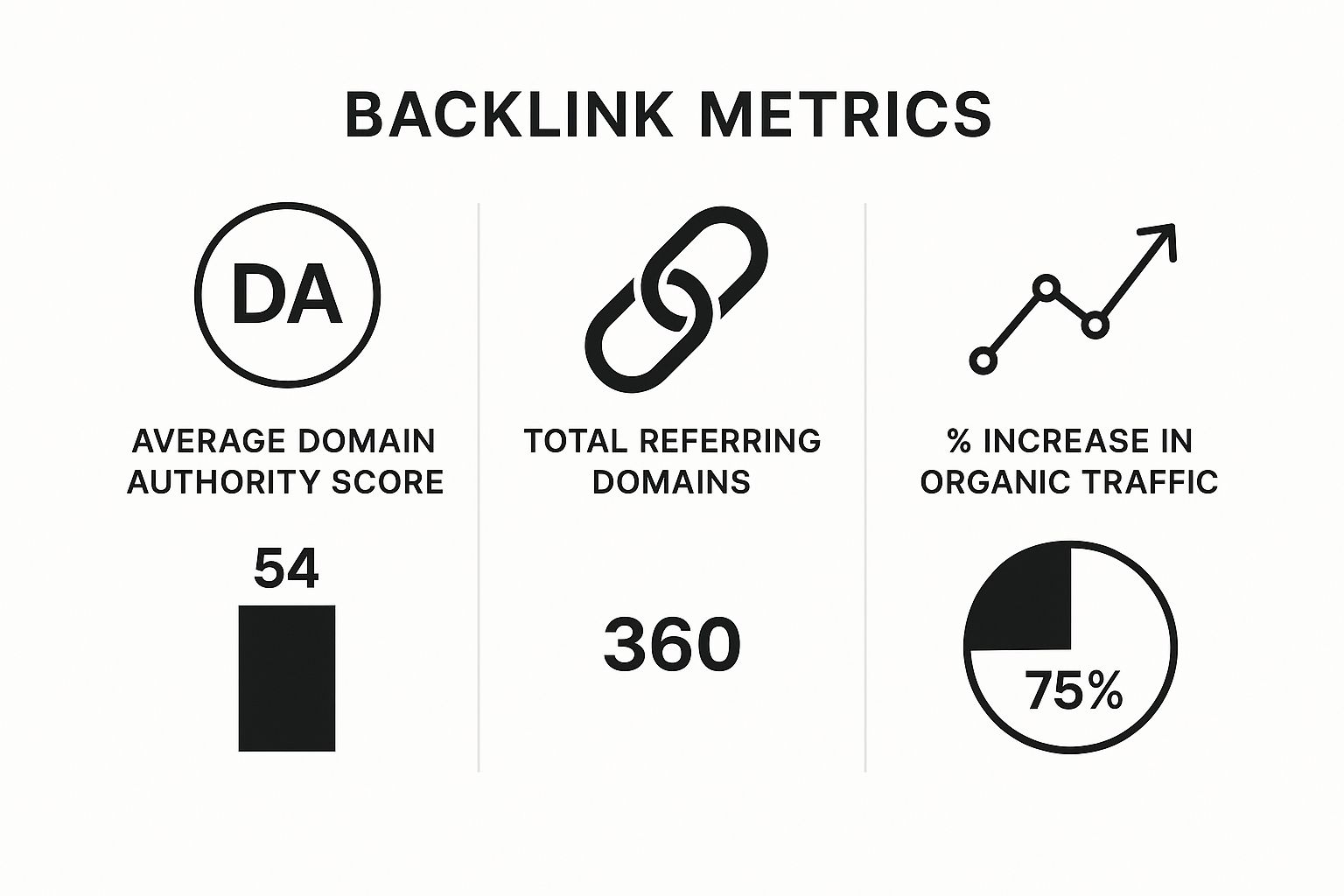Getting your website to the top of Google is about more than just bragging rights. It's a combination of smart technical work, creating fantastic content, and building real authority. The whole point is to convince search engines that you have the best, most trustworthy answer for what people are searching for. When you nail that, you get seen on that all-important first page.

Let's be clear: climbing the search results is a direct line to sustainable growth. It's a powerful engine for traffic, credibility, and, ultimately, revenue. Unlike paid ads, which vanish the second you stop paying, a strong organic presence is an asset that works for you around the clock, constantly attracting potential customers.
The gap between ranking on the first page and being buried on the second is massive. In reality, SEO is a race to page one. Studies show that over 99% of searchers never even bother clicking to the second page, making that digital real estate incredibly valuable.
The click-through rate (CTR) data tells the full story. As you can see from the table below, the drop-off in clicks after the first few positions is dramatic.
SERP PositionEstimated Click-Through Rate (CTR)139.8%218.7%310.2%47.2%55.1%64.4%73.4%83.1%92.7%102.4%
This isn't just about getting any traffic; it's about getting the right traffic. Moving from position #10 to position #3 doesn't just double your clicks—it nearly quadruples them. That's why every single spot on page one counts.
Securing a top spot on Google does more than just bring in visitors; it builds immense trust. People instinctively see organic results as more credible than paid ads. This perception means the traffic you attract is often higher quality and more likely to convert. Think of it as getting a personal recommendation from the world’s most trusted expert—Google itself.
Your organic ranking is a powerful signal of your brand's authority. When you consistently show up at the top for the right searches, you’re not just getting clicks; you're cementing your reputation as a leader in your field.
This authority translates directly into real-world business results:
Understanding the direct line between your ranking and your revenue is the first step. To dig deeper into this topic, check out these expert tips on how to increase website traffic organically. And if you're focused on maximizing your site's visibility, our guide on how to get more website traffic offers a variety of proven methods.

While amazing content is the heart of any SEO strategy, its success is completely dependent on a solid technical foundation. Your on-page and technical SEO elements are the signals you send to search engines, telling them what your pages are about and, more importantly, why they deserve to rank.
Getting these right is one of the most direct ways to improve your organic search ranking. It's not about just checking off boxes on a list. The real goal is to create a seamless experience for both search engine crawlers and the humans who visit your site. This covers everything from the words people see in the search results to the hidden structure of your website.
Your title tag and meta description are your first—and sometimes only—chance to make an impression on the search results page. Think of them as a digital billboard. A great one can dramatically boost your click-through rate (CTR), even if your ranking doesn't budge an inch.
A generic title like "Product Page" is a massive missed opportunity. A much smarter approach is to be specific and highlight a benefit. Something like, “Durable Waterproof Hiking Boots | Free Shipping” instantly tells the user what they're getting, includes the primary keyword, and throws in a compelling offer.
Here’s a quick look at how a weak meta description stacks up against a strong one:
Weak Meta DescriptionStrong Meta Description"This page is about our hiking boots. We sell many types.""Discover our top-rated hiking boots, built for all-terrain comfort and durability. Shop now for free shipping and a lifetime guarantee."Vague and uninspiring. It gives no specific reason to click.Specific and benefit-focused. It uses action-oriented language and highlights clear value, like "free shipping" and a "lifetime guarantee."
The strong example gives users a clear reason to pick your result over a competitor's, which directly impacts your traffic and, ultimately, your bottom line.
How you organize and link your pages together is critically important. A logical site structure does two things: it helps search engines understand the relationships between your pages, and it spreads authority (often called "link equity") throughout your site.
In my experience, a flat and simple structure almost always wins. The goal should be to ensure any page on your site can be reached within just a few clicks from the homepage. A key part of technical SEO is organizing web content in a way that makes sense for both crawlers and users. This means clear navigation menus and a logical hierarchy of parent pages and subpages.
Think of your site's architecture like the foundation of a house. If it’s weak or confusing, everything you build on top of it—no matter how impressive—is at risk of collapsing. A solid structure ensures stability and accessibility for years to come.
This structure also has a huge impact on your site's crawl budget. A well-organized site is simply easier for Google's bots to navigate, ensuring they can find and index your most important pages efficiently. If you're managing a larger site, a deep dive into crawl budget optimization isn't just a good idea—it's essential for maximizing visibility.
Schema markup is a type of code you add to your website's backend to help search engines understand your content on a deeper level. And the reward for this extra effort? Your pages can earn "rich snippets" in the search results—those enhanced listings that include things like star ratings, prices, or event dates right in the SERP.
These enhanced listings pop on the page, which can significantly improve your organic search ranking performance by driving higher click-through rates. Implementing schema is a technical step, but one that delivers a clear visual advantage over competitors.
Here are a few common types of schema you can put to work right away:
By mastering these on-page and technical elements, you're giving search engines a clear roadmap to your best content and creating a better experience for your users. That’s a winning combination for climbing the ranks.

Content is the engine of modern SEO, but let's be honest—churning out thin, generic articles is just a waste of time and digital ink. If you want to improve your organic search ranking, you have to create content that genuinely serves the user while signaling expertise and authority to search engines. The days of ranking with flimsy 500-word blog posts are long gone; today, Google rewards depth and genuine value.
This means your content strategy needs to be deliberate. It doesn't start with writing. It starts with understanding. Before you even type a single word, you need to know exactly how to find your target audience, because that insight will shape every topic you choose and every keyword you target.
Great content begins with deep topic research. Your goal here is to move beyond the obvious, high-level keywords and dig into the specific questions, problems, and pain points your audience is grappling with. You need to think less like a marketer trying to hit a quota and more like a journalist investigating a story.
I've found a few methods that consistently uncover these golden opportunities:
This investigative work ensures you’re not just adding to the noise. You’re creating a resource that fills a real need, which is exactly what Google wants to promote.
One-off blog posts rarely build true authority. To establish yourself as a leader and improve your organic search ranking across a whole range of related terms, you need to adopt the topic cluster model. This is all about organizing your content architecture in a way that screams "expert" to search engines.
Here’s the breakdown:
This structure sends a powerful signal to search engines that you have a deep well of knowledge on a particular subject, which in turn helps lift the rankings for every single piece of content within that cluster.
Think of your pillar page as the trunk of a tree and the cluster articles as its branches. The internal links are the root system, providing stability and channeling authority throughout the entire structure. This interconnectedness is key to demonstrating topical authority.
The data doesn't lie: there's a strong correlation between content length and search ranking. Now, you should never add fluff just to hit a word count, but aiming for genuine depth is a proven strategy. Comprehensive, in-depth articles simply perform better because they are far more likely to fully answer a user's query and cover all the related subtopics they might have.
In fact, content depth is one of the most reliable ways to improve your organic search rankings. Studies have shown that articles exceeding 3,000 words tend to pull in three times more traffic than average-length content. This long-form content also earns significantly more social shares and backlinks—all vital ranking signals for Google.
Ultimately, your goal should be to create the single best resource on the internet for your chosen topic. When you do that, the rankings, traffic, and authority will naturally follow.
And once you've published these valuable assets, making sure search engines see them quickly is just as important. For that, check out our guide on how to increase your Google crawl rate to make sure your best content gets indexed and starts working for you fast.
If great content is the engine of your SEO strategy, then backlinks are the high-octane fuel that makes it roar.
Backlinks—links from other websites pointing to yours—are one of the strongest signals you can send to search engines. They act as a vote of confidence, telling Google that your content is credible, authoritative, and deserves a top spot.
But here’s the thing: not all links are created equal. A single, powerful link from a respected industry leader is worth more than a hundred low-quality links from irrelevant sites. Your ability to improve organic search rankings is directly tied to earning these authoritative endorsements.
The key is to shift your mindset from "building" links to "earning" them. This means creating content and assets so genuinely valuable that others in your niche want to link to them.
The first step in earning quality backlinks is knowing where to look. Chasing every possible link is a surefire way to burn out with little to show for it. Instead, focus your energy on sites that are both relevant to your industry and have established authority of their own.
A link from a major tech blog to your new software tool? That’s a huge win. A link from an unrelated pet grooming site? Not so much.
Start by creating a target list of potential link partners. This could include:
A quick way to gauge a site's influence is by checking its Domain Authority (DA) or a similar metric from SEO tools like Ahrefs or Moz. While not a direct Google ranking factor, it gives you a solid directional sense of a site’s overall strength.
Some types of content are just natural "link magnets." Instead of writing a standard blog post and crossing your fingers, you can strategically create assets designed from the ground up to attract backlinks.
From my experience, these formats consistently deliver the best results:
This image shows the direct impact a successful link acquisition campaign had on organic traffic.

The data is crystal clear: as the number of referring domains from high-authority sources went up, so did the organic traffic. It’s a direct correlation.
Choosing the right link building strategy depends on your resources and goals. Some methods are quick but less sustainable, while others require more upfront effort but pay off for years. Here’s a quick comparison of some effective modern techniques.
StrategyEffort LevelSEO ImpactSustainabilityGuest BloggingMediumHighHighBroken Link BuildingHighMediumMediumDigital PRHighVery HighHighResource Page LinksLowLow-MediumHighUnlinked Brand MentionsLowMediumMedium
Ultimately, a mix of these strategies often works best. Digital PR can land you home-run links, while pursuing resource pages and unlinked mentions provides a steady stream of foundational authority.
While earning external links is crucial, don't ignore the immense power of what you can control on your own site. Internal linking—the simple act of linking from one page on your website to another—is a seriously underutilized strategy for boosting your rankings.
A smart internal linking strategy acts like a series of signposts for search engines, guiding them to your most important pages and showing them how your content is related. It funnels authority from your stronger pages to those that need a boost.
For example, when you publish a new blog post, go back to your older, high-authority articles and find relevant places to add a link pointing to the new piece. This simple action helps the new page get discovered faster and "borrow" some of the authority from the established page. It’s a foundational practice that strengthens your entire site's SEO.
Of course, all the links in the world won't help if Google can't find or index your pages in the first place. If you've built a strong link profile but still aren't seeing results, it's worth investigating potential website indexing issues that could be holding you back.
By combining a strong external and internal linking strategy, you create a powerful, interconnected web of authority that search engines simply can't ignore.
Let's be honest. Traffic and rankings are great for vanity reports, but they don't pay the bills. The real measure of an SEO campaign's success is its direct impact on the bottom line.
It’s your job to draw a straight line from your technical fixes and content work to tangible business outcomes—leads, sales, and cold, hard revenue. This is where so many strategies fall apart. They get stuck on vanity metrics and fail to communicate value in a language that the C-suite actually understands.
If you want to secure long-term investment and support, you have to frame SEO as a core business driver, not just another marketing expense.
Organic search isn't just another traffic channel; it's hands-down one of the most powerful and profitable ones you have. Unlike paid ads, where the traffic disappears the second you turn off the budget, great SEO builds a sustainable asset that keeps generating value for years.
Think about it. A high organic ranking is a massive vote of confidence from Google. It builds trust with potential customers before they even click through to your site.
That inherent credibility is precisely why organic leads often convert at a higher rate. They found you by actively searching for a solution, not because an ad interrupted their day. This high-intent traffic is the lifeblood of any sustainable business.
The data backs this up in a big way. A whopping 70% of online marketers agree that SEO is more effective than PPC for driving sales. And for B2B, it's even more stark: an incredible 61% of B2B marketers say SEO and organic traffic generate more leads than all other marketing initiatives combined. You can dig into more of this data by reviewing these key industry statistics.
Tracking the journey from a search click to a real conversion is how you prove ROI. It’s the only way. You have to set up clear goals in your analytics platform to see what visitors from organic search are actually doing. This is how you shift the conversation from "We got more traffic" to "We generated more qualified leads."
Here’s how you connect the dots:
By focusing on conversion metrics, you completely change the narrative. A report showing a 25% increase in demo requests from organic search is infinitely more powerful than one just showing a traffic spike.
Ultimately, your goal is to forge an undeniable link between your SEO work and the company's financial health. When you can confidently walk into a meeting and say, "Our new content strategy led to a $50,000 increase in the sales pipeline," you've won. You’ve demonstrated the true power of what you do.
Even with a solid strategy, the road to better organic rankings is filled with questions. You're putting in the work, but it’s only natural to wonder if you’re focusing on the right things, how long it will actually take, and what truly moves the needle.
Let's dig into some of the real-world questions I hear all the time from teams trying to scale their search traffic. Getting straight answers here can help you manage expectations and pour your energy where it counts.
This is the million-dollar question, and the only honest answer is: it depends. Anyone promising you #1 rankings in 30 days is selling snake oil. SEO is a long-term investment, not an overnight flip of a switch. For most sites, seeing meaningful, needle-moving results takes anywhere from four to twelve months.
What causes such a wide range? A few key factors:
My advice? For the first three months, forget about sales and focus on leading indicators. Look for keyword rankings improving (even moving from page 10 to page 3 is a win!), a steady climb in organic impressions, and a growing number of indexed pages. These are the early signs that prove your strategy is on the right track.
When you’re starting with a blank slate, the sheer number of "SEO best practices" can feel paralyzing. You can't do it all at once, so you have to prioritize.
For a brand-new website, this is where I’d put every ounce of my energy first:
Notice what’s not at the top of the list? Aggressive link building. While it becomes critical later on, your first priority is to create a website and a body of content that actually deserves to earn links.
This one is a persistent myth, so let's set the record straight: There is no direct link between running Google Ads and where you show up in the organic results. You can't pay Google to boost your organic rankings. The two systems are run by different algorithms and teams.
However, there is a powerful indirect connection that smart marketers exploit. Running PPC campaigns gives you a treasure trove of data you can use to make your SEO strategy much sharper.
PPC BenefitHow It Helps SEOKeyword DataGet immediate feedback on which keywords actually drive clicks and conversions, helping you prioritize what to target with your SEO content.Ad Copy InsightsTest different headlines and descriptions in your ads to see what language gets people to click. Use that winning copy in your title tags to boost organic CTR.Increased Brand AwarenessSeeing your brand in both the paid and organic sections builds trust and recognition, which can lead to more people clicking your organic result.
So while you can't buy your way up the organic ladder, you can absolutely use paid campaigns as a research lab to improve your organic search ranking more strategically.
There isn't a magic number here—it's all about relevance and accuracy. The simple rule is to update content whenever it's no longer the best, most comprehensive answer for a searcher's query. A good habit is to run a content audit at least twice a year.
Keep an eye out for pages with:
Of course, after you've made those valuable updates, you want Google to notice them right away. Waiting for a natural re-crawl can take weeks. This is a good time to look into how you can request Google to crawl your site faster and make sure your fresh content gets the credit it deserves as soon as possible.